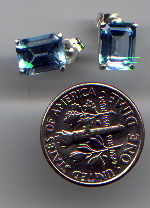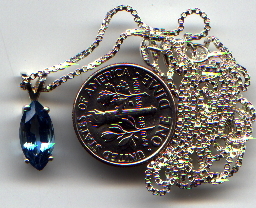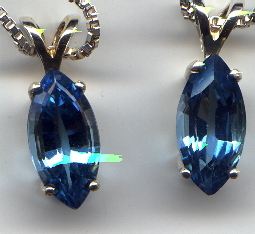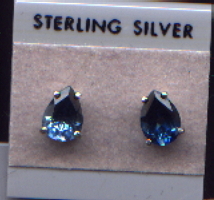





These are six necklaces I've made from various gemstone bead materials. All the findings (clasp, jumploops, bead tips, liquid silver tube beads and 2mm spacer beads) are all made of genuine sterling silver. Look at the patterns, colors and textures. They are pleasing to the eye, and none of them are 'extreme.' Any of these necklaces could be worn clubbing, or in the board room. The leaf shaped beads are carved Rock Crystal, which can be very expensive. Buy in bulk whenever possible and save your wallet! There are two kinds of freshwater pearls shown here. The long smooth ones are freshwater rice pearls, and the rounder ones are pond grown freshwater pearls. The pond grown pearls were three times the cost of the regular freshwater pearls, however the pond grown pearls have a deep lustre and nacre, and I've yet to find any as nice. Please note that Rose Quartz will fade in direct sunlight, so be careful where you store it when not in use.
As you can see by the dime, these images are slightly smaller than actual size. All these necklaces are at least 18 inches, and some are as long as 22 inches or more. When I make necklaces, I like to make them at least long enough to fit over my head with some room to spare. That way you don't need to bother with the clasp.






, Goldstone, Hematite, Smokey Quartz (faceted), Garnet, Iolite, Citrine (heat treated amethyst), Peridot, Blue Topaz, Carnelian, Rock Crystal (leaves), Genuine Citrine, Pond Grown Freshwater Pearls, Mother of Pearl, and Turquoise.
<p>
<img src= )






Most semi-precious gemstone beads are either radiated, heat treated or dyed. Rarely do these beads come in their 'natural' state, since semi-precious gemstone beads are usually grades of gemstone that don't make the faceted gemstone grade. When purchasing gemstone beads, look for the 'grading' given. Such as 'Grade B' Lapis Lazuli has a lot more gold flecks of pyrite, and is usually not as dark. A grade will have a much deeper blue color, and a little of the gold flecks of pyrite. All transparent gemstone beads, such as garent, blue topaz, iolite, citrine, etc. will have inclusions in them. This is very typical. The quality grading given will tell you how bad the inclusions are. No inclusion gemstone beads are hidiously expensive, and therefore not purchased often. However, some D grade gemstone beads have really interesting inclusions that can work to your advantage, if you take color, texture, shape and size into account when making your jewelry. Any reputable source will tell you how these beads were treated. Dyed garnet should be washed in warm water first, so that the dye dosen't spread on your thread, clothing, etc. I've never had a problem with any of the other colors, so it must be the type of dye they use.

4 mm Garnet Bead Strand C+ Grade & 6 mm D Grade Amethyst Bead Strand
There is a big difference between gemstone bead STRANDS and actual jewelry. The picture above shows what a gemstone bead strand typically looks like. It is temporarily threaded and there are no clasps or bead tips. Bead strands are simply beads strung on thread for purchase. Many people on E-bay and Yahoo don't understand the difference between finished jewelry and bead strands. Unless the listing says 'necklace' figure it's temporarily threaded beads and remember that when you bid on it. The real color of this strand is a good clean medium burgundy-red, but my scanner shows them to be much darker than they really are. When looking at scans of garnet of any kind, make sure to ask if that is the true color or not before buying.
I also do gemstone jewelry. The items below are Swiss Blue Topaz, all eye clean and set in Sterling Silver. I've included a close up of the marquise shaped pendants.






CUT STYLES
Emerald Cut - This shape is a rectangle. The hardest kind to set into a jewelry setting.
Heart Cut - This is a Trillion cut with additional cuts to form it into the shape of a heart.
Marquis Cut - This is a modified diamond cut, with the outside edges rounded off.
Oval Cut - This is simply an oval.
Pear Cut - This is also known as a Teardrop shape. It looks like a pair (the kind you eat).
Princess Cut - Square Cut. It's still hard to find settings for this shape of stone.
CALIBRATION
It is very important to buy gemstones that are calibrated--this means they fit in any standard setting that is easy to find. Uncalibrated stones are worth much less money, and you usually need a jeweler to custom make a setting for that stone. To see calibrated sizes, I suggest you go to: http://www.jamminggems.com and go to their settings to see the size and shapes available. Don't ever buy a stone unless you know it's calibrated! And, don't trust the seller if they say it is calibrated. Go instead by the size and dimensions listed, then look on jamminggems.com and see if there is a setting in that size.
We've had
visitors to this site.

Special Events
Put up pictures from special occasions, such as parties, weddings, and graduations.
[$phototitle3 IS UNDEFINED!!!]